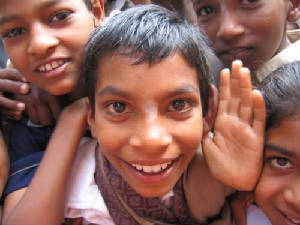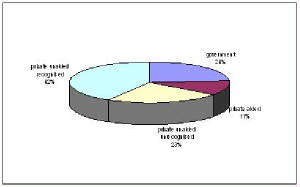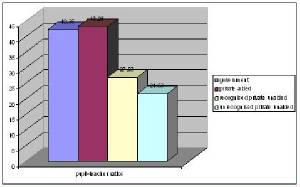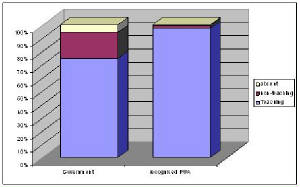|

Despite the common perception that private education serves only the needs of the privileged, there is
a growing body of evidence that points to the phenomenon of private schools for the
poor, in a range of developing countries.
My recent research was motivated by these findings to examine the extent to which private education
is meeting the needs of the poor in five countries: Ghana, Nigeria, Kenya, India and China. The work, conducted by the
University of Newcastle Upon Tyne, England, using research teams in each country from universities or NGOs, is funded by the
John Templeton Foundation, USA. The aim
is to catalogue the nature and extent of private education for poor families, and to conduct systematic comparisons between
the public and private sectors serving the poor. The project commenced in April 2003, and is engaged in final analysis of
results now.
This briefing paper highlights some of the findings, structured around ten points:
- In areas researched, the majority of
poor children attend private unaided schools In total, 65%
of school children attend private unaided schools in ‘slum’ areas of three zones of the Old City of Hyderabad.
The same percentage of children are in unrecognised private unaided as there are
in government schools (23% compared to 24%).
See, for example, The Probe Team (1999) Public Report on Basic Education in India.
Oxford and New Delhi:
Oxford University
Press, and Watkins, K. (2000), The Oxfam Education Report. Oxford: Oxfam in Great Britain.

- Higher achievement in private unaided
than government schools Recognised and unrecognised private unaided schools outperform government schools in mathematics and English, and differences in Urdu and Telugu are statistically
insignificant. After controlling for all background variables, an average child
would obtain 41% in a government school
in mathematics. The same child would obtain 55%
in an unrecognised and 60% in
a recognised private unaided school. In English, the same marks would be 27% (government), 41% (private unrecognised) and 48% (private recognised).

- Gender equity in private unaided school
enrolment Half of pupil enrolment (50.3%) in private unaided schools is female. It is not the
case that private unaided schools have higher enrolment of boys.
- School enrolment underestimated Because many children are in unrecognised private schools that do not feature in government statistics, overall
enrolment is much higher than figures suggest. About 80,000 children may be unaccounted for – about 30% of total enrolment,
and considerably more than the total number who attend government schools.

- Better pupil-teacher ratios and more
teaching in private unaided than government schools Pupil-teacher
ratios in unrecognised private unaided schools are half those in government schools – 22:1 compared to 42:1. In recognised
private unaided schools, the figure is 27:1, and private aided schools have the highest of all.

98% of Class 4 teachers in recognised
private unaided schools were teaching when researchers called unannounced, compared to only 75% in government schools. Only
one teacher was absent, (0.5%), compared to 6% in government schools.

- Better facilities in private unaided
than government schools Private unaided schools offer more facilities for their children than
government schools:
·
63% of recognised private unaided schools have
desks in every classroom, compared to less than 2% in government schools.
·
96% of unrecognised private unaided schools have
drinking water for their children, compared to only 58% of government schools.
·
97% of unrecognised private unaided schools have
toilets for children, compared to only 52% of government schools.
·
85% of recognised private unaided schools have
separate toilets for boys and girls, compared to only 11% of government schools.
·
Only 1% of government schools have a library compared
to 33% of recognised private unaided schools.
- Pupils and parents in private unaided
schools more satisfied Pupils in private unaided schools and their parents report greater satisfaction
than their government counterparts:
·
56% of government parents are dissatisfied or
very dissatisfied with school facilities, compared to only 11% of private unaided parents.
·
37% of government parents are dissatisfied or
very dissatisfied with the provision of extra-curricular activities, compared to only 12% of private unaided parents.
·
70% of private unaided pupils reported that school
discipline was excellent, compared to only 44% of government pupils.
·
32% of government pupils said their school buildings
were ‘poor’ or ‘very poor’, compared to only 3% of private unaided pupils.
- Teachers largely satisfied in private
unaided – even unrecognised – schools Despite receiving considerably lower salaries
than those in government schools, teacher satisfaction is in general higher for private unaided than government school teachers:
·
84% of teachers in unrecognised PUA schools were
‘very satisfied’ with their teaching, compared to only 64% in government schools.
·
50% of government teachers were very or quite
dissatisfied with school facilities, compared to only 5% of unrecognised private unaided and no recognised private unaided
teachers.
·
62% of government teachers said they were very
or quite dissatisfied with school infrastructure, compared to 10% of unrecognised private unaided and no 5% of recognised
private unaided teachers. These differences were statistically significant.
- Private unaided schools cost significantly
less than government schools in teacher and per pupil costs The private unaided school advantage
is achieved for considerably less expenditure than in government schools:

- The average monthly teacher salary in a government school is nearly four times higher than in an unrecognised private unaided school, and over
twice as high as in a recognised private unaided school
- The poorest are given free or subsidised
seats in private unaided schools Notwithstanding the fact that private unaided schools need income
from pupils to survive, the majority offer free or concessionary places to those in need:
·
One in five of all children in private unaided
schools have free or concessionary seats provided for them. 7% have free places,
and 11% concessionary seats.
|

